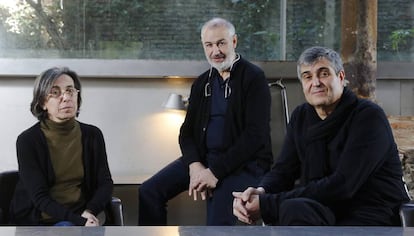Catalan Architects RCR win Pritzker Prize
Rafael Aranda, Carme Pigem and Ramon Vilalta to receive the prestigious architectural award


"OK, OK, OK….” Carme Pigem, 54, is thrilled, if slightly subdued. She is the one who took the phone call announcing that her team had won the Pritzker Prize. “I believed them right away because nobody jokes about these things,” she says. But then she admits that ever since the call, she has been living with the fear that they might, somehow, lose the award.
Reporters from The New York Times and CNN have come to Olot, in the Catalan Province of Girona, where she and her colleagues - her husband Ramon Vilalta, 56, and Rafael Aranda, 55 - have devoted themselves to architecture for three decades in a way that is almost religious.
The jury found in RCR’s work a sense of respect between the present and the future, as well as a coexistence between the local and the universal. The close collaboration between the three designers, the importance of craftsmanship and the search for universal identity won the Pritzker Prize for three professionals who met at the Vallès School of Architecture, at the Polytechnic University of Catalonia (UPC), and decided to work together.
Only one Spaniard has ever won the award before this, Rafael Moneo in 1996. This year’s winners believe that another architect undoubtedly deserves the award: "Enric Miralles, of course".
The jury found in RCR’s work a sense of respect between the present and the future
Although several duos have won the prize – including Herzog & de Meuron and Sejima and Nishizawa - this is the first time the award has gone to a team of three architects. Today, the desk that the three share will be filled with architectural designs rather than cava wine.
Their decision to work together was made at the age of 24, when they returned from their first trip to Japan. “On the plane we designed the cherry wood table that we have shared for the past 30 years,” said Aranda. While it was their school and the landscape of their childhood in La Garrotxa that inspired the trio to work together, it was the trip to Japan that shaped their architectural views. In Japan they learned the importance of the “journey” that leads to the final structure.
The importance that the team have always given to the landscape is a result of this “journey”. Perhaps this explains why one of their first works, the Tussols-Basi athletics track in Olot (2000), was designed to complement the landscape of trees that surrounds it.
But people have also helped to shape RCR’s work. “Houses have been our laboratory,” Pigem said. Their first successes were extraordinary houses for ordinary people, avant-garde housing for blacksmiths, carpenters or hairdressers. Their perfectionism is such that there is a rumor that they force owners to sign contracts that prevent them from later modifying their work. They deny it. “When architecture is consistent, it allows everything,” said Vilalta.
After redesigning half of Olot, RCR decided to start working outside their region. At the Petit Comte de Besalú kindergarten they tested a more industrialized form of architecture that they then used in the French schools of Font Romeu. Pierre Soulages, one of France’s most famous living painters, commissioned RCR to design the museum to which he left his legacy in Rodez, not far from Olot, on the other side of the Pyrenees.
Long before they designed Albert Adrià’s ground-breaking new Barcelona venture, Enigma, RCR were behind the exclusive Les Cols restaurant in Olot. “Surrounded by orchards and chickens, we had, for the first time, to ask ourselves how to communicate with what was already there.”
They decided to do it not by changing the space but by giving it its own voice. From then on, the name of these three architects would forever be associated with that of chef Fina Puigdevall. Together they bear witness to how avant-garde architecture and haute cuisine can coexist with agriculture and kilometer-zero thinking.
Carme Pigem, Ramon Vilalta and Rafael Aranda will collect their Pritzker Prize award on May 20th at the Akasaka Palace in Tokyo.
Minimalism and nature
Although RCR believe that “there is only one architecture, that which contributes to physical and spiritual well-being”, the Pritzker is leaving behind an era when social architecture - like Japanese architect Shigeru Ban's emergency homes - seemed to represent the future of the profession. The demanding, minimalist work of RCR is a tribute to architecture understood as an art form that affects our daily life without giving up on its aesthetic aspirations.
English version by Marina Ayala, Francisco Javier Pujol, Marta Andreu and Marialena Yannoulatou.
elpais.cat in English
From November 2016 onward, the Catalan edition of EL PAÍS, Elpais.cat, has been publishing a selection of news stories in English.
The texts are prepared by journalism students at the Pomepeu Fabra University (UPF), who adapt content from Catalan current affairs every week, adding extra information and explanation to these stories so that they can be understood in a global context.
Tu suscripción se está usando en otro dispositivo
¿Quieres añadir otro usuario a tu suscripción?
Si continúas leyendo en este dispositivo, no se podrá leer en el otro.
FlechaTu suscripción se está usando en otro dispositivo y solo puedes acceder a EL PAÍS desde un dispositivo a la vez.
Si quieres compartir tu cuenta, cambia tu suscripción a la modalidad Premium, así podrás añadir otro usuario. Cada uno accederá con su propia cuenta de email, lo que os permitirá personalizar vuestra experiencia en EL PAÍS.
¿Tienes una suscripción de empresa? Accede aquí para contratar más cuentas.
En el caso de no saber quién está usando tu cuenta, te recomendamos cambiar tu contraseña aquí.
Si decides continuar compartiendo tu cuenta, este mensaje se mostrará en tu dispositivo y en el de la otra persona que está usando tu cuenta de forma indefinida, afectando a tu experiencia de lectura. Puedes consultar aquí los términos y condiciones de la suscripción digital.








































